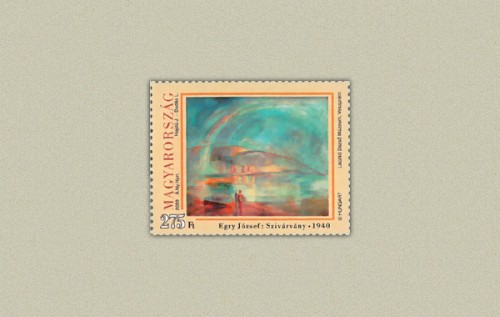
1. MAGYAR - MŰVÉSZETEK 2009 - BALATONT ÁBRÁZOLÓ FESTÉSZET - Bélyeg rendelési kód: 2009 év bélyegei kompletten
2. ENGLISH - THE ARTS 2009 (1) RAINBOW BY JOZEF EGRY - Order code of the stamp: 2009 Year stamps complete
3. GERMAN - KÜNSTE 2009 (1) JOZEF EGRY: REGENBOGEN, Gemälde - Die Bestellnummer Der Marke: 2009 Jahr Briefmarken komplett
1. MAGYAR - MŰVÉSZETEK 2009 - BALATONT ÁBRÁZOLÓ FESTÉSZET
A Magyar Posta Művészetek elnevezésű alkalmi bélyegsorozatán neves magyar alkotók műveit mutatja be.
A 2009. évi újdonságok egyik címletén Egry József: Szivárvány (1940) c. festménye látható. A bélyeghez tartozó alkalmi borítékra a Kilátás Fonyód felé (1936) c. alkotás került. Az alkalmi bélyegző grafikáján a művész portréjának stilizált rajza látható. A bélyegen és a borítékon látható alkotások a veszprémi Laczkó Dezső Múzeum tulajdonát képezik, és a badacsonytomaji Egry József Emlékmúzeum állandó kiállításában tekinthetők meg.
Egry József (Zalaújlak, 1883. március 15. – Badacsonytomaj, 1951. június 19.) Kossuth-díjas magyar festőművész, a magyar modern festészet egyik legeredetibb képviselője. Festészeti tanulmányait Korcsek Jánosnál kezdte, majd Münchenben folytatta. 1905-ben Lyka Károly segítségével Párizsba utazott, ahol főként a modern festészetet tanulmányozta. Visszatérve 1906-1908 között a Képzőművészeti Főiskolán Ferenczy Károly és Szinyei Merse Pál tanítványa volt. 1907-ben a Menhely előtt c. képével nyert állami ösztöndíjat. 1909-ben kollektív kiállítása volt a Művészházban. 1912-ben Belgiumban járt. Katonáskodása után, 1918-tól élt a Balaton mellett és számtalan változatban megfestette a magyar tengert. Az 1920-as évektől kezdve műveinek csaknem kizárólagos témájává vált a Balaton. Először az expresszionizmus formanyelvén fejezte ki magát, majd egyéni stílust teremtett: sajátos technikájú olajpasztell képei szuggesztív látomásban egyesítik az embert és a természetet.
1924-ben Ernst-díjat, 1926-ban Szinyei–tájkép díjat, 1945-ben állami nagydíjat nyert. A Kossuth-díjat 1948-ban kapta meg. 1938-ban a Képzőművészek Új Társasága elnökévé választották. Képei megtalálhatóak a Magyar Nemzeti Galériában, a pécsi, keszthelyi múzeumban, valamint magángyűjteményekben egyaránt. (Forrás: www.hung-art.hu)
Megjelenési időpont: 2009. szeptember 10.
Forrás: Philatelia Hungarica Kft., Magyar Posta
2. ENGLISH - THE ARTS 2009 (1) RAINBOW BY JOE EGRY
Magyar Posta is presenting the works of famous Hungarian artists in its series of special stamps entitled The Arts. One of the new stamps of 2009 shows the painting Rainbow by József Egry (1940). Another of his paintings, View towards Fonyód (1936), has been used on the first day cover for the stamp. The design of the special postmark is a stylized portrait of the artist. The works used for the stamp design and first day cover are owned by the Dezső Laczkó Museum in Veszprém and are on display in the permanent exhibition of the József Egry Memorial Museum in Badacsonytomaj.
József Egry (Zalaújlak, 15 March 1883 – Badacsonytomaj, 19 June 1951), the Kossuth prize winning Hungarian artist, was one of the most original artists in modern Hungarian painting. He began studying painting under János Korcsek and continued in Munich. In 1905, with Károly Lyka’s help, he travelled to Paris, where he mainly learnt about modern painting. Returning to Budapest, he studied at the Academy of Fine Arts under Károly Ferenczy and Pál Szinyei Merse between 1906 and 1908. In 1907 he won a state scholarship with his painting In front of a Night Asylum. In 1909 he had a group exhibition in the Artists’ House and in 1912 he went to Belgium. After military service he moved to Lake Balaton in 1918 and from then on painted the lake known as the ‘Hungarian sea’ in countless versions. From the 1920s on Lake Balaton became almost the only subject he painted. At first he used expressionism and then developed his own individual style for his paintings using his unusual pastel oil technique combining man and nature in suggestive visions.
He won the Ernst Prize in 1924, the Szinyei Landscape Award in 1926 and the state grand prix in 1945. He was awarded the Kossuth Prize in 1948. In 1938 he was chosen president of the New Society of Fine Artists. His works are exhibited in the Hungarian National Gallery, museums in Pécs and Keszthely, and private collections. (Source: www.hung-art.hu)
Date of issue: 10 September 2009
3. GERMAN - KÜNSTE 2009 (1) JOZEF EGRY: REGENBOGEN, Gemälde
Die Magyar Posta präsentiert in ihrer Sonderbriefmarkenserie Künste Werke berühmter ungarischer Künstler. Auf einer Marke der Novitäten 2009 ist das Gemälde von József Egry Regenbogen (1940) zu sehen. Auf dem Sonderumschlag der Marke ist das Werk Aussicht auf Fonyód (1936) abgebildet. Auf der Grafik des Sonderstempels ist die stilisierte Zeichnung des Porträts des Künstlers zu sehen. Die auf der Marke und auf dem Umschlag abgebildeten Werke sind Eigentum des Laczkó-Dezső-Museums in Veszprém und können in der ständigen Ausstellung des Egry-József-Gedenkmuseums in Badacsonytomaj besichtigt werden.
József Egry (15. März 1883 in Zalaújlak; † 19. Juni 1951 Badacsonytomaj), ungarischer Kunstmaler, Kossuthpreisträger, einer der originalsten Vertreter der ungarischen modernen Malerei. Seine Studien als Maler begann er bei János Korcsek, die er später in München fortsetzte. In 1905 reiste er mit Unterstützung von Károly Lyka nach Paris, wo er in erster Linie die moderne Malerei studierte. Nach seiner Rückkehr war er zwischen 1906 und 1908 Schüler von Károly Ferenczy und Pál Merse Szinyei an der Hochschule für Bildende Kunst. In 1907 gewann er mit seinem Bild „Vor dem Asyl“ ein staatliches Stipendium.
In 1909 war seine kollektive Ausstellung im Künstlerhaus. In 1912 hielt er sich in Belgien auf. Nach seiner Militärzeit lebte er von 1918 am Balaton und malte das ungarische Meer in unzähligen Variationen. Von den 1920er Jahren an wurde der Balaton schier zu seinem ausschließlichen Thema. Anfangs drückte er sich in der Ausdruckskunst des Expressionismus aus, später schaffte er einen eigenen Stil: Seine mit eigenartiger Technik gemalten Ölpastelle vereinen den Menschen und die Natur in einer suggestiven Vision.
In 1924 gewann er den Ernst-Preis, in 1926 den Szinyei–Landschaftsbild-Preis und in 1945 den staatlichen Großen Preis. Den Kossuthpreis erhielt er in 1948. In 1938 wählte man ihn zum Vorsitzenden der Neuen Gesellschaft der Bildkünstler. Seine Bilder sind in der Ungarischen Nationalgalerie, in den Museen in Pécs und Keszthely sowie in Privatsammlungen auffindbar. (Quelle: www.hung-art.hu)
Erscheinungsdatum: 10. September 2009










